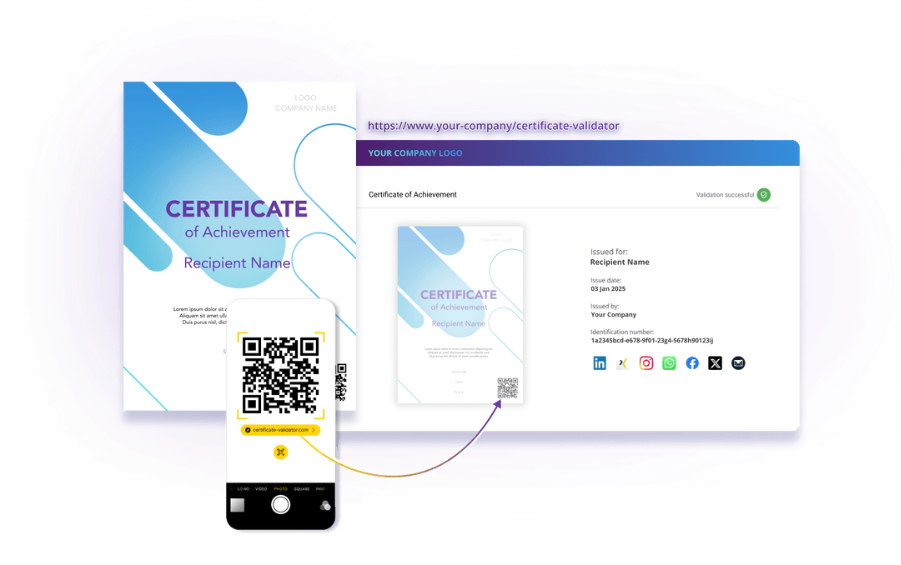No user accounts required for your recipients -
Existing certificates and badges always stay valid


How educational providers can prepare for the next decades of verifiable, shareable and automated credentialing



The era of static PDF certificates is coming to an end. For decades, educational institutions have relied on downloadable files that were easy to issue but difficult to verify or share. Today, digital transformation and the growing demand for authenticity are pushing a new generation of credentials into the spotlight: verifiable and interactive digital certificates.
Modern digital certificates are no longer simple documents. They are dynamic credentials that can be verified in real time and easily shared online. Each certificate includes metadata such as the recipient’s name, issuing institution, date, and course details. Verification pages allow anyone to confirm authenticity instantly, reducing the risk of falsification.
The shift from PDFs to dynamic certificates is driven by several key factors:
This evolution transforms certificates from mere proof of completion into powerful marketing and credibility tools for educational providers.
With the rise of online learning, manual certificate creation has become inefficient and error-prone. Automation is now essential for educational providers aiming to manage high participant volumes while maintaining quality and consistency.
Virtualbadge.io allows institutions to generate and distribute certificates automatically once learners meet specific criteria, such as course completion or event participation. This streamlines workflows and minimizes administrative effort.
Key benefits of automation include:
The article How to Automate Certificate Issuance with Virtualbadge.io shows how automation enables educators to scale efficiently while maintaining a consistent learner experience.
By adopting automation early, institutions gain not only operational efficiency but also a modern, tech-forward image that aligns with the future of education.
Digital certificates have evolved into valuable marketing tools that extend far beyond verifying participation. When learners share their verified credentials on professional networks like LinkedIn, they amplify the reputation of both themselves and the issuing institution. This organic visibility often reaches audiences that traditional advertising cannot target.
Modern certificate systems make this process seamless. Learners receive a shareable link or badge that connects directly to an online validation page. With one click, their achievement becomes part of their professional profile; visible to employers, colleagues, and future students.

Key benefits of social sharing:
Several training providers have already used this strategy to strengthen engagement. For example, educational organizations that encouraged participants to share their credentials on LinkedIn saw measurable increases in course visibility and enrollment interest. Digital certificates thus serve a dual purpose: recognizing achievement and promoting the institution behind it.
With digitalization, the need for secure and verifiable certificates has never been greater. In the coming years, security and validation will remain at the center of innovation in credential management.
To prevent misuse and falsification, modern certificates integrate real-time verification tools that confirm authenticity instantly. These typically include:
The key is transparency: every stakeholder (from the learner to the employer) should be able to confirm that a credential is legitimate within seconds.
By adopting robust validation standards, educational providers not only protect their brand integrity but also foster lasting trust in the digital learning ecosystem.
The pace of change in digital certification is accelerating. Institutions that act early will gain a decisive advantage in efficiency, visibility, and credibility. The next decades will favor educational providers that combine automation, verification, and learner engagement into one coherent system.
To stay ahead, institutions should focus on three priorities:
A practical example of this future-oriented approach can be found in the Fit4Emergency case study, where a training provider digitized its certification process, saving time and improving both trust and reach.
Digital credentialing is not just about technology; it is about positioning your institution as a trustworthy and forward-thinking education provider.
Digital certificates are transforming from simple proofs of completion into powerful tools for credibility and visibility. Institutions that embrace automation, verification, and shareability will stand out in the coming years.
By modernizing their certification process, educators can save time, prevent fraud, and strengthen their brand presence online.
Ready to take the next step?
Schedule a free demo with Virtualbadge.io and discover how easy it is to issue secure, verifiable, and shareable certificates.
* You can find the organisation ID in the URL when you access your LinkedIn Company page as an admin.


Marketing
Nov 14, 2025
4 min
Use Virtualbadge.io to design and send digital certificates that create trust - in less than 10 minutes.